Installing OnSSI Ocularis Plugin
This topic covers installing a Video API Plugin for OnSSI Ocularis 64bit (VMS). Instructions include installing MSMQ, the OnSSI Runtime SDK, and the Middleware Service on Galaxy server. Also included are the steps to add the VMS login credentials to System Galaxy, connect to the VMS, and import the camera names.
FEATURED TOPICS
OnSSI Ocularis Video Plugin 64bit (Server)
This step describes installing the Video Plugin file on the computer that hosts the Galaxy GCS Services.
PREREQUISITES
-
Verify GCS Web API Service is running:
Test URL > http://localhost:8000/swagger or https://X.X.X.X:8334/swagger (SSL)
-
The OnSSIOcularis.exe plugin install file is under the Auxiliary folder on the Galaxy Install media (USB/ISO).
Path > USB:\\Auxiliary\System Galaxy\Video Plugins\OnSSIOcularis
STEPS
-
Copy the OnSSIOcularis.exe file into the OnSSIOcularis folder on the Galaxy Services Computer.
NOTE: you must create the OnSSIOcularis folder if it does not exist.
Your PC > C: \\GCS\System Galaxy\Video Plugins\OnSSIOcularis
-
Right-click on the OnSSIOcularis.exe file and choose ‘Run as Administrator’ from the menu.
The Plugin should self extract.
Extracting Video Plugin file
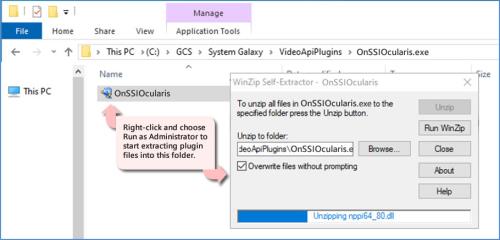
Enable Microsoft Message Queue (Server)
This step covers turning on the MS Message Queue option on the computer that hosts the GCS Services.
PREREQUISITES
-
The MS Message Queue must be installed on the same computer that is hosting the GCS Services.
-
The message queue feature must be turned on before you install the SDK.
-
You must restart the computer after turning on the MS Message Queue .
STEPS
-
Open Windows Control Panel from the Windows Search Bar.
-
Select (click) the Programs option to open the Programs window.
-
Select (click) the Program and Features option to open the Programs and Features window.
-
Select (click) the Turn on Windows Features option, in the left side pane of the window.
Turn On Windows Features (MSMQ)
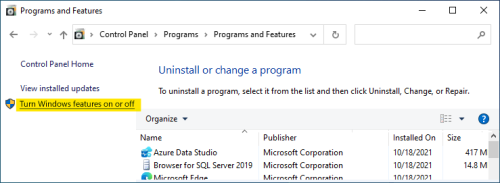
-
Expand the Microsoft Message Queue (MSMQ) Server option. Then expand the Microsoft Message Queue (MSMQ) Server Core option.
-
Check (enable) the MSMQ Active Directory Domain Services Integration
-
Check (enable) the MSMQ HTTP Support
Configuring MSMQ Options
-
-
Click OK to save MSMQ changes. Then close all the Control Panel windows.
-
Restart the Computer to initialize these settings.
Install OnSSI Runtime SDK (Server)
This step covers installing the OnSSI Runtime SDK on the computer that hosts the GCS Services.
PREREQUISITES
-
The MS Message Queue must already be properly configured (see prior section).
-
The OnSSI runtime 64bit SDK must be installed on the same computer hosting the GCS Services.
-
Galaxy’s GCS Web API Service must be running or the SDK will not install.
-
You must restart the computer after installing the SDK.
STEPS
-
Browse to the OnSSI x64 SDK Installer (.EXE file) on the computer running GCS services.
C:\\GCS\System Galaxy\Video Plugins\OnSSIOcularis\Installers\ONSSI Runtime\OnSSI Ocularis SDK Runtime x64*.exe
-
Right-click the OnSSI SDK Installer file and choose to ‘Run as Administrator’.
Launch the OnSSI Runtime SDK (64bit)

-
The Installer program will open, click NEXT to begin.
-
During the installation process, the Installer program will prompt the user to download and install the .NET Framework, if needed.
The Installer program will automatically upgrade/update and install several run-time components, including Visual C, DirectX, and .NET Framework.
Download supporting framework for Ocularis SDK
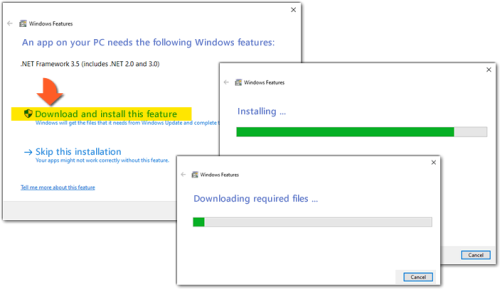
-
Click Finish to close the Installer Program after everything is installed.
-
Restart the Computer to initialize these settings.
Install Middleware Connector Service
This step covers installing the OnSSI Middleware Connector Service on the computer that hosts the GCS Services.
PREREQUISITES
-
The SG ocularis X64 Middleware will be installed on the same computer that is hosting the GCS Services.
-
Galaxy’s GCS Web API Service must be running, or the Ocularis Middleware .EXE will not install.
-
You must restart the computer to initialize the services.
STEPS
-
Browse to the SG OnSSI x64 Middleware Installer (.EXE file) on the computer running GCS services.
C:\\GCS\System Galaxy\Video Plugins\OnSSIOcularis\Installers\SG_Ocularis_X64_MiddleWare_Installer.exe
-
Right-click the OnSSI Middleware Installer file and choose to ‘Run as Administrator’.
Launch the OnSSI Runtime SDK (64bit)

-
The Installer program will open, click NEXT to begin.
-
You can accept the default temp folder location (desktop).
NOTE: The installer will remove the temp folder after it finishes installing.
-
Click Install button (see figure below).
Installing OnSSI Ocularis Middleware (64bit)

-
Click FINISH when the installer is done.
-
Restart the computer to initialize the services starting up.
-
Open the PC Services window, verify the status of the ‘OnSSI Connector Service’ is “Running” and is configured to “Automatic” start-up.
Ocularis service status is Running/Automatic

Install Video Plugin (Client)
This step covers installing the video plugin file on a Galaxy client workstation.
You can skip this step if you do not need Video at a client workstation.
PREREQUISITES
-
The GCS Web API Service must be running.
-
The GCS Services Computer must be online.
-
The options that are related to Video Viewing and Monitoring must be enabled at this client. Refer to the Setup Checklist Item-4 in for details.
STEPS
-
Copy the OnSSIOcularis.exe file into the OnSSIOcularis folder on the Galaxy Services Computer.
NOTE: you must create the OnSSIOcularis folder if it does not exist.
Your PC > C: \\GCS\System Galaxy\Video Plugins\OnSSIOcularis
-
Right-click on the OnSSIOcularis.exe file and choose ‘Run as Administrator’ from the menu.
The Plugin should self extract.
Extracting Video Plugin file

Connect to VMS & Import Cameras
This step describes adding the client login and connecting to the VMS Unit and importing the camera names.
PREREQUISITES
-
The VMS Unit must already be installed, configured and online.
-
The VMS client login for Galaxy must already be created at the VMS Unit and must have the correct permissions to view all cameras.
-
All camera names must be configured at the VMS unit before you add the VMS to System Galaxy.
-
The GCS Web API Service and the OnSSIOcularis Connector Service must be running.
-
You must know the IP Address of the VMS Unit (or web address if hosted over the internet)
-
You must know the VMS’s client login credentials (Username/Password).
IMPORTANT: Camera names cannot be changed in System Galaxy. Camera names must be configured at the VMS Unit before they are imported into System Galaxy when the VPI Programming is done (this step). The imported names will display in screens and reports throughout System Galaxy, including the SG Hardware Tree, Reader Programming screen, Input Programming screen, and the GCS VPI Video Viewer. TIP: Create camera names that are useful - like what area it shows - e.g., lobby mezzanine, east parking lot, employee entrance, elevator lobby cam1.
STEPS
-
Open the Plugin Screen - Configure > Hardware > DVR’s > Video Plugins
-
In the Plugins window, select “OnSSIOcularis” and click [OK] button and the VMS Programming screen will open.

-
Enter a unique and meaningful Name (i.e. “OnSSIOcularis 01”).
FYI: This name is displayed throughout System Galaxy screens and reports - such as Hardware Tree, DVR Properties, Camera Programming, or Reader & Input screens, etc.
-
Enter client login credentials (User or Domain & Password). Login rights must allow viewing/controlling cameras.
-
Enter the Web Services URL of the VMS unit (port number is not needed).
-
Click the [TEST] and [SAVE CONNECTION] buttons, which will test the connect and import the camera names.
-
Click [SAVE SYSTEM DATA] button, to save VMS connection settings and camera names into the SG database.
IMPORTANT: You must restart System Galaxy software after saving data to initialize the VPI system configuration.
VMS Programming & Camera Import - DEFAULT PORT = NONE
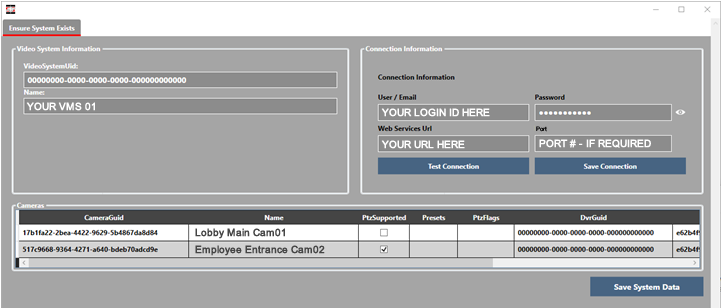
The fields available may vary for your brand of Video Plugin.
Test the VMS & Cameras
This step tests that the VMS Unit and cameras were added correctly and that you can play video from a chosen cameras.
PREREQUISITE
-
You must have completed the previous section by saving your System Data and restarting System Galaxy.
STEPS
Launch System Galaxy and sign-in if you have not already done so. The Hardware Tree should be open.
TIP: You can refresh the Hardware Tree from the View menu.
-
Click the DVRs icon (+
 ) to see the list of VMS Units.
) to see the list of VMS Units.RESULT > you should see the VMS Name that you created in the previous step.
-
Click on your VMS Name (+
 ) to see the list of cameras imported.
) to see the list of cameras imported.NOTE: If you did not create custom camera names in the VMS Unit before you imported, then you will see the default camera names from the VMS – such as Camera 1, Camera 2, (…), a serial number, or whatever the default naming scheme of your VMS unit.

Do not change cameras in Galaxy after the import is done. Camera names in Galaxy must exactly match the camera names in the VMS Unit. You must create custom or specified camera names in the DVR/VMS Unit before you do the camera import step.
VMS Unit & Cameras listed in the SG Hardware Tree
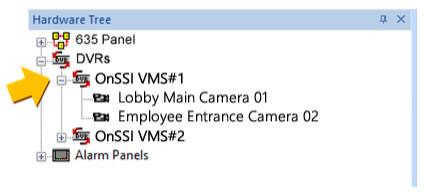
-
Right-click a Camera icon
 and select ‘View Live Video’ from the menu.
and select ‘View Live Video’ from the menu.RESULT > the Video Viewer plays live video from the chosen camera. (Test every camera)
-
When you have tested all your cameras, you can link the cameras to the SG hardware ( readers & inputs ).
|
|
See Part-3 Configure Cameras to link cameras to readers or inputs. |
|
|
See the Hardware Programming sections in SG User Guide for assigning cameras to readers and inputs as well as configuring them to respond to alarm conditions such as “Door Forced Open” or “Armed Alarm”. |
.
